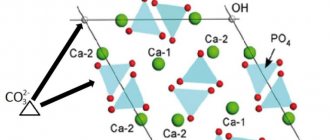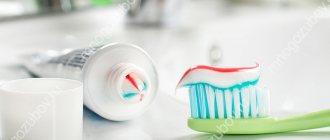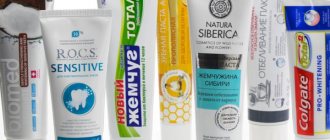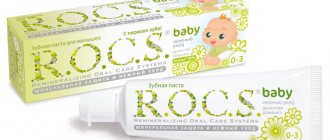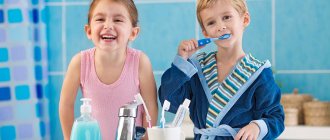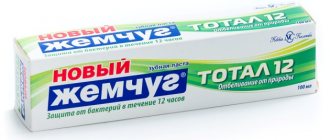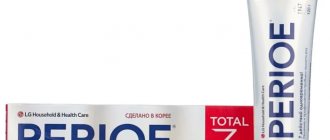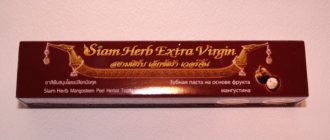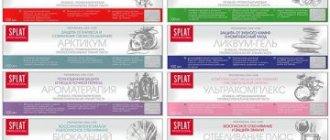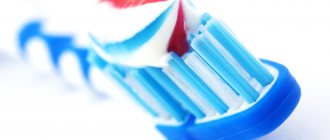- Types of toothpastes
- Properties of toothpastes
- Composition of toothpastes
- Choosing toothpaste according to problem
How many of us buy toothpaste? They make a shopping list and go to the hypermarket. If this sounds like you, then most likely you underestimate the role of toothpaste in your health. A good toothpaste protects against caries, ensures that teeth do not lose minerals, and most importantly, does not harm the enamel. In this article, we will analyze in detail the compositions of modern pastes and tell you how to choose the one that really suits you.
Main components
Abrasives are responsible for removing plaque, otherwise known as cleaning or polishing agents. These include baking soda, silicon compounds, calcium carbonate or calcium phosphate. More expensive toothpastes contain a substance called hydrating silica, which is a better alternative to baking soda or calcium phosphate.
The abrasiveness of toothpastes is determined using the abrasiveness index. On the packaging it is marked with the abbreviation RDA (Relative Dentin Abrasivity). This indicator was invented by the American Dental Association. RDA determines the ability of a paste to disrupt the structure of tooth enamel and produce mechanical effects (enamel abrasion). It is believed that effective plaque removal is achieved with RDA values just above 100. Regular toothpaste consists of half abrasive components. If it contains more than 50% polishing agents, it can cause tooth sensitivity.
Almost any toothpaste contains foaming agents that save consumption and help fight plaque. However, large amounts of such substances cause irritation and redness in the mouth.
Flavorings and flavoring additives are added to the paste. Also, for normal consistency, toothpastes need binders (also called hydrocalloids) - components that help retain moisture so that bacteria do not grow in the paste, and preservatives.
Without all these components, toothpaste will not work. However, often instead of harmless natural flavors, abrasives and preservatives, chemists use harmful and life-threatening substances.
What should not be in toothpastes
- Lauryl sulfate (Sodium Lauryl Sulfate) is a foaming agent that is part of cleaning products. Causes burning and itching in the mouth.
- Propylene glycol is a solvent used in industry. It is used as antifreeze or brake fluid. Particles that enter the body settle in the liver and kidneys and negatively affect their functioning.
- Triclosan (Triclosanum) is an extremely dangerous antibiotic that kills not only pathogenic microorganisms, but also has a detrimental effect on the kidneys and lungs. In medicine it is used only as prescribed by a doctor.
- Paraben is a preservative that increases the shelf life of products. It can be found not only in pastes, but also in shampoos, shower gels and bath foams. It is believed that this substance affects the development of malignant tumors. In 2004, experts studied the levels of parabens in breast cancer tumors. The presence of these substances in malignant tumors has indeed been proven, but the real reasons for their appearance have not been identified.
- Polyphosphates are a substance that softens water. Polyphosphates are included in almost all washing powders. There are suggestions that this particular component can cause an inflammatory process in the oral cavity.
- Chlorhexidine is a substance with an antimicrobial effect that can kill any microflora. With frequent use it causes dysbacteriosis in the oral cavity.
Benefits of natural remedies
The most important advantage of natural cosmetics is the natural origin of the components included in its composition, which not only perfectly cope with their functions, but also do not harm health.
There is an opinion that natural teeth cleaning products are also not able to effectively cope with problems such as whitening, for example, or decreased sensitivity. But this is just a misconception. In fact, natural ingredients can take just as good care of a person’s oral cavity.
In addition, several more significant advantages of natural-based paste should be highlighted:
- Most of these products are certified. And this indicates their unconditional safety and high quality;
- packaging is often self-degrading, which also, albeit to a small extent, helps preserve nature.
- they are not tested on animals;
- when producing products with a natural composition, there is no release of harmful substances into the atmosphere due to the absence of synthetic components;
Composition of toothpaste depending on type
Pastes are divided into two main types: hygienic and medicinal. The former freshen breath and eliminate plaque, the latter fight a specific problem. Dentists, in turn, divide medicinal pastes into several more types. Only a dentist can help you choose the right remedy.
Sensitive paste
The doctor will recommend it if your gums and enamel are sensitive. This product contains potassium salts and strontium chloride. In this case, there should be extremely few abrasive substances in the paste. A substance called hydroxyapatite can also reduce gum sensitivity.
Examples of sensitive toothpastes:
- LACALUT Extra Sensitive.
- Sensodyne Gum health.
- PRESIDENT Sensitive.
#LIFEHACK
Doctors usually advise patients with hypersensitive teeth to use special gels, for example, the Russian drug RemarsGel, which cannot be found in pharmacies, but can be purchased to order in online stores. Sensitive gel is also available in the line of products under the brand name ROCS (Medical Sensitive Gel).
Whitening toothpaste
The main substances in this product are hydrogen peroxide and sodium bicarbonate. The composition may also contain an abrasive index (on the packaging it is designated as the RDA index) equal to 200, but in this case the paste cannot be used daily; it must be alternated with other brands every two to three days. However, your dentist should give more precise instructions for use. Regular toothpastes have RDA values slightly above 100.
Examples of whitening toothpastes:
- WhiteWash NANO.
- Lacalut White.
- Oral-B 3D White.
Anti-inflammatory paste
This remedy is prescribed by a doctor when periodontal disease or periodontitis is detected. In the composition of such pastes you can often find extracts of medicinal herbs.
Examples of anti-inflammatory toothpastes:
- Parodontax classic.
- DIAVIT Diadent Active.
- ASEPTA Active.
Strengthening toothpaste
Necessary for those who have enamel caries (light brown spots on the surface of the teeth). Such pastes must contain either fluoride or calcium. These two substances cannot be present together. It is also worth noting that fluoride in large quantities is harmful to teeth and can cause a disease called fluorosis (damage to tooth enamel). Fluoride paste should not be used for more than three weeks. A more effective and safer alternative to fluoride is glycerophosphate or calcium gluconate.
Examples of strengthening toothpastes:
- President Unique.
- Splat Biocalcium.
- ASEPTA Remineralization.
Application
- Hygienic. Remove dental plaque. Recommended for people with healthy teeth. Contains useful microelements and antiseptic additives.
- Fluorine-containing. Used to strengthen teeth. Fluoride-containing pastes should be used after consultation with a doctor: some filling materials are destroyed by fluoride.
- Medicinal. The composition contains antibacterial components, protects against caries, and helps prevent diseases of the teeth and gums. Natural extracts, oils, minerals, and biologically active components are used as additives.
- Whitening. Contain abrasive particles and additives to lighten tooth enamel. Recommended for occasional use. Does not eliminate the formation of tartar.
- Children's. They contain substances that have a positive effect on the health of baby teeth, strengthen gums, and disinfecting components.
- Anticarious. Active components penetrate into hard-to-reach places, strengthen enamel, and reduce tooth sensitivity. Ways to stop caries in the initial stages.
- Anti-inflammatory. For sensitive gums. Contains components with antibacterial, antimicrobial, hemostatic effects. Activate the processes of restoration of tissues and mucous membranes.
Toothpaste and braces
When installing braces, you need to be more careful when choosing toothpaste. After all, the non-removable structure creates additional difficulties when brushing your teeth. In addition, while wearing braces, it is necessary to abandon whitening toothpastes so that after removing the corrective devices, the teeth are the same color. Dentists advise changing toothpastes at certain stages of teeth correction. For example, in the first months after installing braces, calcium is actively lost from the teeth, so pastes with a high content of this substance are needed. Then it is important to eliminate possible risks of caries, so strengthening toothpastes are suitable. At the final stages of wearing braces, doctors recommend switching to anti-inflammatory pastes to prepare the patient for painless removal of corrective systems. When choosing, you need to pay attention to the brands of those companies that specialize in producing toothpastes for braces, and consult with the treating orthodontist.
Examples of toothpastes for braces:
- ROCS PRO Brackets & Ortho.
- Gum Ortho.
- Dentaid Vitis Orthodontic.
Is it worth paying extra for luxury toothpaste?
Premium toothpastes add expensive and higher quality components, for example, hydroxyapatites, which are also called artificial tooth enamel. They help fight acids that are present in the mouth.
In addition, fluorine and fluorides are not found in luxury pastes; they are replaced with theobromine. This substance, which is obtained from cocoa beans, strengthens enamel and has an antibacterial effect.
Doctors also advise not to skimp on oral care products if you have recently installed an implant. Special toothpastes (Curasept ADS 712, Bluem, Implaclean) help the implant take root and have a good effect on the condition of the gums. When choosing between regular and premium toothpastes, you should understand that an expensive product will not help if you do not follow basic hygiene rules and do not visit the dentist every six months.
Prevention of caries
Caries is the most common disease in the world. This is a pathological process of destruction of hard tooth tissues. It begins with a white spot and ends with pulpitis and various septic processes with inevitable tooth loss.
The main cause of caries is bacteria that produce acids. They wash fluoride and calcium out of the tooth tissue and weaken it. Frequent consumption of sweets accelerates the development of carious bacteria: carbohydrates are a favorite environment for their reproduction. Teeth with thinned enamel are also at risk: through microcracks, bacteria penetrate into the dentinal tubules and begin to destroy the tooth from the inside.
The most important stage in effectively combating caries is early diagnosis of the problem and, of course, prevention. Remove plaque at least once every 12 hours, and visit the dentist every 6 months!
In addition to caries, the TOP 5 most common dental problems are:
- Raid.
- Unpleasant smell.
- Sensitive enamel.
- Bleeding gums.
- Color change.
Harmless composition of children's toothpaste
When choosing toothpaste for a child, you need to look at the amount of fluoride. This substance is essential for children's teeth, but can be toxic in large quantities. Children from one to four years old need to select a toothpaste with a fluoride concentration of no more than 200 ppm (a unit of concentration that stands for parts per million). For children from 4 to 8 years old, products containing no more than 500 ppm of fluoride are suitable. From 8 to 14 you need to choose a paste with a fluoride content of about 1400 ppm.
You also need to look at the degree of abrasiveness. For children under four years of age, the RDA index should be no more than 20 USD, and for older children - no more than 50 USD. e.
Examples of children's toothpastes:
- Rocs Pro Kids.
- BioRepair.
- Splat baby.
